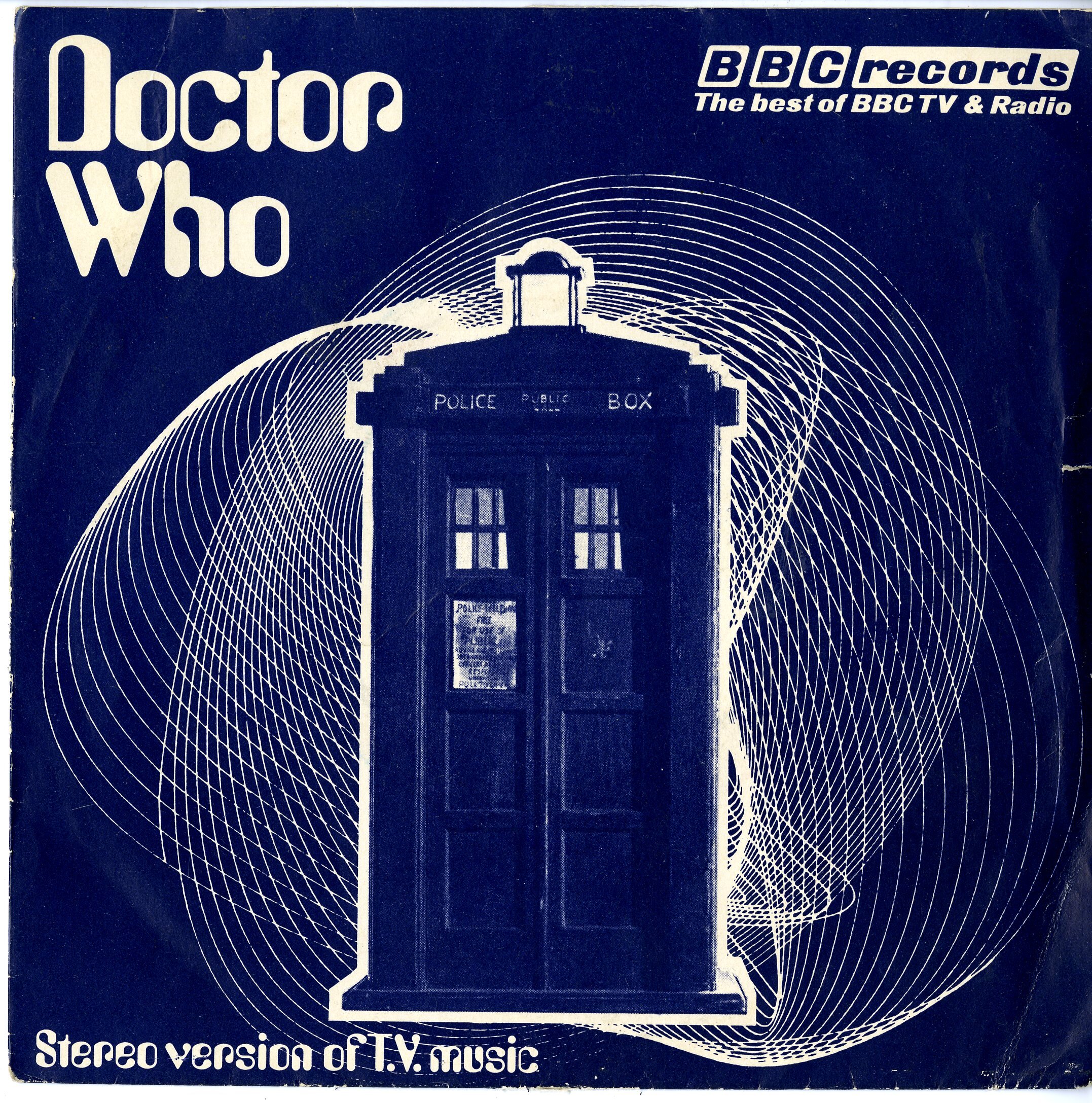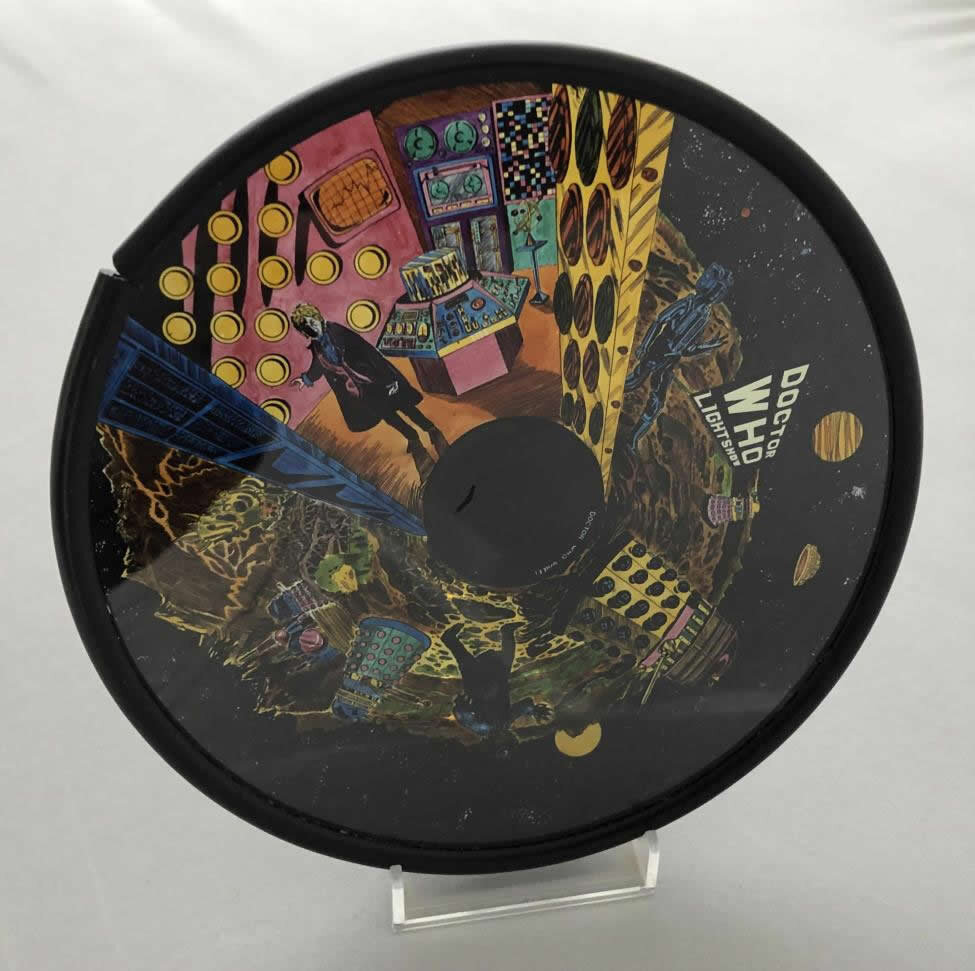go straight to the pictures
Doctor Who’s tenth anniversary year, 1973, again provided many opportunities for collectors. There were several new items of exclusively Doctor Who merchandise, as well as other collectibles featuring Doctor Who. One new set of merchandise, in particular, is fondly remembered by many and remains a staple of collections today.
A stereo version of the Doctor Who theme was released as a 7-inch single by BBC Records (catalogue no. RESL 11, b/w Reg). Two versions are available: one with a blue and white label, and the second with a silver label. A picture sleeve can also be found. Later in 1973, BBC Records released another single record – “Moonbase 3/The World of Doctor Who.” This included music from The Mind of Evil and Planet of the Daleks composed by Dudley Simpson and realized by Dick Mills. An electronic cover version of the theme by Don Harper’s Homo Electronics was released by Columbia Records (catalogue no. DB 9023, b/w World of Sport). This version of the theme also appeared the following year on Don Harper’s eponymous album from Columbia (catalogue no. SCX 6559).
A couple of obscure Doctor Who-related records also appeared in 1973. “Jawbone” by Injun Jo was the B-side to York Records’ “Feel the Rhythm Inside” (catalogue no. SYK 580). This is a novelty track described as a country/trucking song in the voice of the Daleks that was written and performed by Miki Anthony (who had much greater success as the writer and composer of The Goodies’ “Funky Gibbon”). Another single, “Dr. Who” from Panther Records (catalogue no. P. 68) was written and composed by Lee Perry and performed by Jamaican reggae artist, I. Roy.
Other merchandise included four new jigsaw puzzles from Whitman Publishing featuring photographs from “The Three Doctors,” “Day of the Daleks,” and “The Green Death.” A “Doctor Who Space Mission Pad,” a notepad that produced “instant copies” and included a card for creating secret codes, was produced by Naocroft Ltd. for The Save the Children Fund. Transflair Ltd. produced a Dr. Who “Iron Ons” t-shirt transfer in which the third Doctor is attacking a Dalek with a ray-gun. Around this time, a “Doctor Who Lightshow” wheel was produced. This is a coloured glass disc illustrated with images of the Doctor in the TARDIS, Daleks, a Cyberman, and a Sea Devil that was rotated in front of a spotlight to produce lighting effects for parties and discos. The Lightshow wheel was reportedly advertised in music magazines at the time, but nothing more appears to be known about it. Finally, World Distributors, well known for the Dr. Who annual, produced “The Dr Who Colouring Book” this year.
This was a great year for Doctor Who book collectors. World Distributors issued “The Dr Who Annual 1974” in late 1973. However, the most significant event was the start of the Target Books range from Universal-Tandem Publishing in May 1973. The first three novels were paperback reprints of the Frederick Muller hardcovers published in 1964 and 1965 and appeared as “Doctor Who and the Daleks,” “Doctor Who and the Crusaders,” and “Doctor Who and the Zarbi.” I received these books as a gift around the time of publication – for me, as for many fans, the Target books are a beloved part of my childhood. This website cannot do justice to the Target phenomenon, so I encourage you to find David J. Howe and Tim Neal’s “The Target Book” from Telos Publishing for an extraordinarily rich history of the range, and Paul Smith’s “Based on the Popular BBC Television Serial” from Wonderful Books, which is the comprehensive guide to every edition and variant of the published novels.
1973 also started out as a great year for Doctor Who in comics. “TV Action” was restyled with issue 101, dated 20th January. The “Countdown” name was dropped from the title and the Doctor Who strip no longer started on the front page of each issue. However, on a rotating basis, each of TV Action’s principal comic strips appeared on the cover with a full-page Gerry Haylock painting plus a multi-page “Big Story” strip inside the comic. Doctor Who was the Big Story and so appeared on the cover of issues 104, 112, 120, 123, and 131. TV Action also regularly featured Doctor Who content, often with photographs, in its TV Screen Scene section and its letters page. Sadly, TV Action ended with issue 132 dated 25th August 1973 and the Doctor Who comic strip returned to Polystyle’s “TV Comic” the following week in issue 1133, dated 1st September 1973 and continued there until 1979. There was also a TV Action Holiday Special and TV Action Annual published in 1973, both of which included Doctor Who content. Polystyle also published a Doctor Who Holiday Special this year.
1973 was another good year for Doctor Who in the Radio Times. The first issue of the year – covering 30th December 1972 – 5th January 1973 – included an iconic cover photo of the first three Doctors under the headline “Which Doctor is Who?” and a two-page article featuring interviews with Carole Ann Ford, Frazer Hines, and Katy Manning. Each of the weekly listings from the start of The Three Doctors to the end of The Green Death included a small Frank Bellamy illustration. With Jon Pertwee’s final season beginning before Christmas, a second Doctor Who cover appeared in 1973. The issue dated 15th-21st December featured Jon Pertwee and Michael Parkinson on the cover under the headline “Who’s your Friend?” and another two-page article. More information about Doctor Who content in the Radio Times can be found HERE.
The Radio Times issue dated 15th-21st December 1973 also announced the publication of the “Doctor Who Radio Times Special.” The Special included a year-by-year summary of the Doctor Who stories from the beginning of the serial, interviews with a number companions, and plans (though not entirely accurate) for building a Dalek. The Radio Times Special subsequently became available as part of a chain store promotion in New Zealand from late 1975 to early 1976. Following the launch of NZBC’s channel TV2 and the broadcast of Jon Pertwee episodes on the new channel from September 1975, specially marked copies of the magazine were available for $1.40 with the purchase of a pair of Levi jeans. The magazine was not available to buy on its own from shops. (Information on the NZ promotion courtesy of Jon Preddle.)
Another version of Jon Pertwee’s BBC TV Doctor Who cast card was released; this version with Pertwee’s biography on the back. This period saw a continuing high profile for Pertwee’s Doctor through public appearances and other promotions. Pertwee promoted a book entitled “Baking Your Cake and Eating It” from the Co-Op, which featured an illustration of him on the back cover and also in a two-page advertisement in the Radio Times issue dated 29th September – 5th October. On a personal note, I saw Jon Pertwee for the first time when he made a personal appearance with a Dalek at a fête in Heigham Park, Norwich, which, of course, received local press coverage. The BBCtv Special Effects Exhibition that started at the Science Museum in London in December 1972 continued until May 1973 and then relocated to the Middlesbrough Town Hall Exhibition Centre from 5th July until 31st December. A similar BBC special effects exhibition, prominently featuring Doctor Who, was held at Longleat between Easter and October as a result of Lord Bath visiting the exhibition at the Science Museum. This preceded a permanent exhibition at Longleat beginning in 1974.
Articles about Doctor Who and its stars continued to appear in newspapers and magazines, and some are presented in the Gallery. Notably, the Whomobile that would first appear in Invasion of the Dinosaurs from mid-January 1974 received good publicity in the media during its design and construction by Peter Farries in Nottingham. Early broadcasts of some Pertwee stories in the United States were advertised in the US “TV Guide.”
Go to the Photo Gallery
Next Year
Previous Year
Return to the









